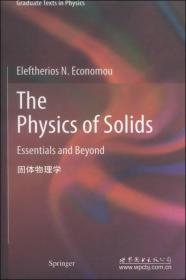
固体物理学(英文版)
批量上传,套装书可能不全,下单前咨询在线客服! 正版书 !!!
¥ 103.53 6.9折 ¥ 149 全新
库存5件
四川成都
认证卖家担保交易快速发货售后保障
作者(希)艾克拿默 著
出版社世界图书出版公司
ISBN9787510077876
出版时间2014-07
装帧平装
开本其他
定价149元
货号23600472
上书时间2024-10-18
- 最新上架
商品详情
- 品相描述:全新
- 商品描述
-
导语摘要
艾克拿默编著的《固体物理学》内容介绍:In selecting the material and the presentation of this textbook I was aiming at the advanced undergraduate/first year graduate level, or so I was intending. Chapters 1-8 (with some possible omissions and additions, depending on the students' interests and the instructor's preferences) can serve as the core of a senior undergraduate course on Solid State Physics addressed to students in Physics, Chemistry, Materials Science, and Engineering. The book is designed to serve also as a textbook in, a first-year graduate course on the Physics of Solids. Some familiarity with Electromagnetism, Quantum Mechanics, and Statistical Physics is assumed; anyway, extensive outlines of these subjects are presented in Appendices A, B, and C, respectively.
目录
Part ⅠAn Overview
1 Basic Principles Summarized
1.1 The Atomic Idea: From ElementaryParticles to Solids
1.2 Permanent (i.e., Equilibrium) Structures of Matter Correspond to the Minimum of Their (Free) Energy
1.3 Condensed Matter Tends to Collapse Under the Influence of Coulomb Potential Energy
1.4 Quantum Kinetic Energy Counterbalances Coulomb Potential Energy Leading to Stable Equilibrium Structures
1.4.1 Heisenberg's Uncertainty Principle and the Minimum Kinetic Energy
1.4.2 Pauli's Exclusion Principle and the Enhancement of the Minimum Kinetic Energy
1.4.3 Schrodinger's Spectral Discreteness and the Rigidity of the Ground State
1.5Dimensional Analysis
1.6 Key Points ,
1.7Questions and Problems
2 Basic Principles in Action
2.1Size and Energy Scale of Atoms
2.2 Why do Atoms Come Together to Form Molecules and Solids?
2.3 Ionic Motion:- Small Oscillations
2.4 Why do the Specific Heats of Solids go to Zero as T→OK?
2.5When is Classical Mechanics Adequate?
2.6 Estimating Magnitudes Through Dimensional Analysis
2.6.1Atomic Radius, Ra
……
Part Ⅱ Two Simple Models for Solids
Part Ⅲ More About Periodicity & its Consequences
Part Ⅳ Materials
Part Ⅴ Deviations from Periodicity
Part Ⅵ Correlated Systems
Part Ⅶ Appendices
内容摘要
艾克拿默编著的《固体物理学》内容介绍:In selecting the material and the presentation of this textbook I was aiming at the advanced undergraduate/first year graduate level, or so I was intending. Chapters 1-8 (with some possible omissions and additions, depending on the students' interests and the instructor's preferences) can serve as the core of a senior undergraduate course on Solid State Physics addressed to students in Physics, Chemistry, Materials Science, and Engineering. The book is designed to serve also as a textbook in, a first-year graduate course on the Physics of Solids. Some familiarity with Electromagnetism, Quantum Mechanics, and Statistical Physics is assumed; anyway, extensive outlines of these subjects are presented in Appendices A, B, and C, respectively.
相关推荐
— 没有更多了 —




















以下为对购买帮助不大的评价